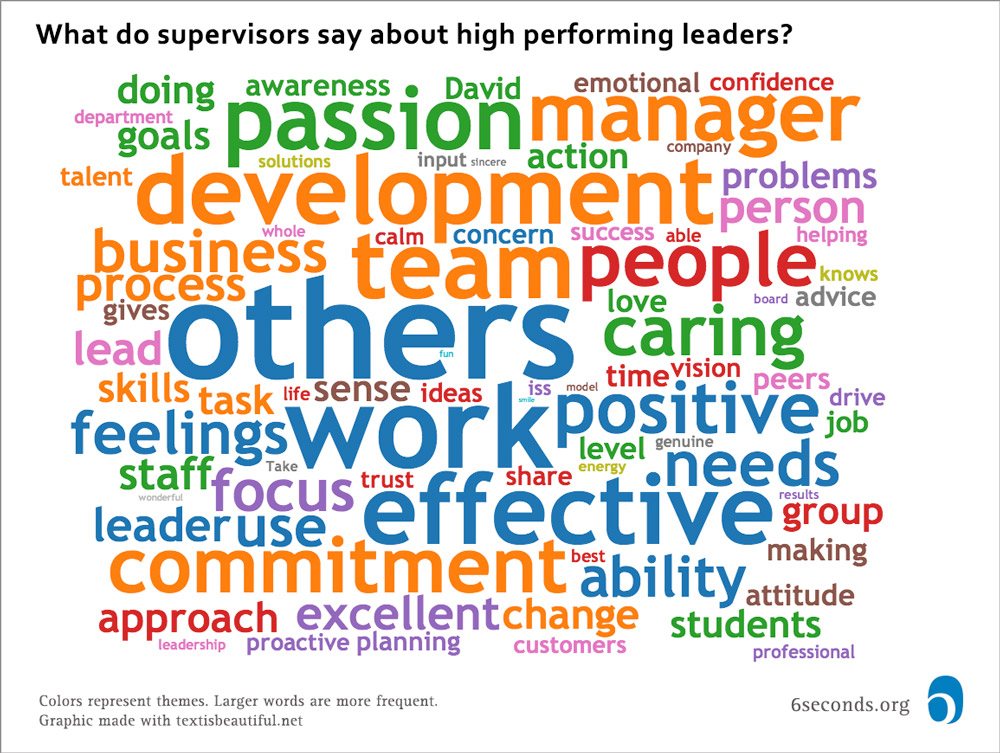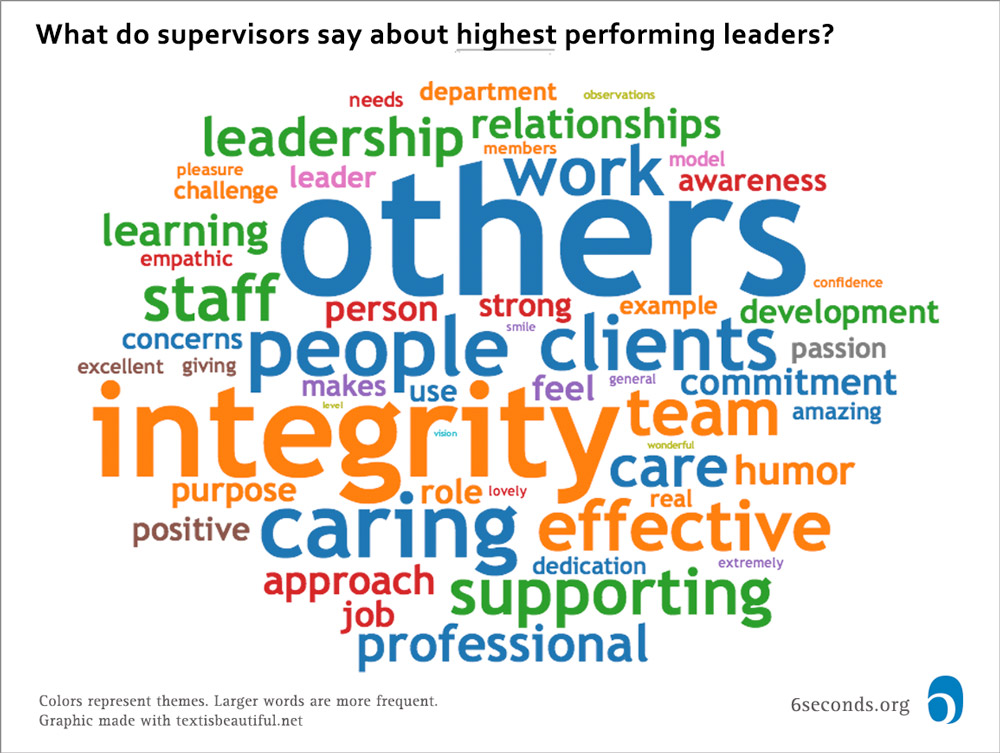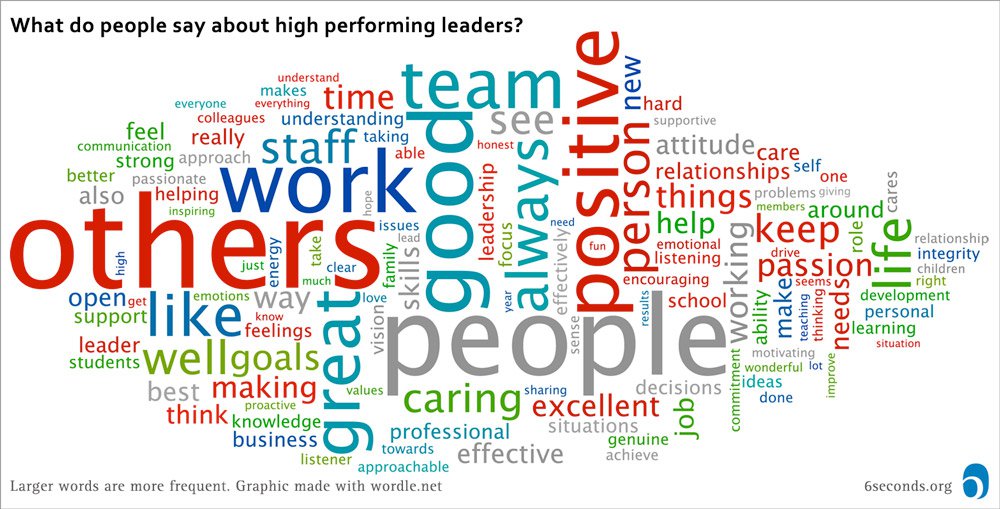What creates exceptional leadership today? What if you could “peek inside” the relationships of thousands of leaders with their teams, colleagues, supervisors, and even customers – what would you see? Hint: It’s a about people-leadership.
By Joshua Freedman, Lorenzo Fariselli, Massimilano Ghini & Giacomo Nottoli
In our research to create the Brain Talent Profile, we analyzed thousands of anonymous open-text comments about high performing leaders. We coded these to identify specific talents, and distilled down to 18 essential talents for breakthrough performance.[1] In the process, we were moved by the incredible comments about these leaders – and found that there are certain themes that distinguish strong leaders from exceptional ones, particularly in the realm of people-leadership.
If you had a magic wand, what would you like your people, colleagues and supervisors to say about you?
Here’s a peek at comments on effective leaders:
The graphic above is made with Wordle.net, and more frequent words are larger. As you can see, the focus is on others – on people – on work, being positive, and good. The way people talk about leaders turns out to matter a great deal, and in subtle ways. The highest performing leaders in our sample get comments like these from their direct reports:
- The most hard working and conscientious person I have ever worked with – she is a brilliant leader and always considers the feelings of those around her.
- He always makes himself available to everyone within the organization.
- A fantastic people-person. Genuinely has our best interests at heart while also staying focused on the organization’s goals and business needs.
- Empowers his team to take control of their operation, doesn’t shy away from making decisions or taking chances.
- Definitely the most trustworthy person I know.
- She is totally fab, really concerned with everyone on her team and how she can help.
What would you call a leader who embodies these characteristics?
Research: Attributes of Exceptional Leaders
We extracted two variables from our SEI360 database [2]: Performance and open text answers to the question, “what is s/he doing now (that is effective) that you’d like to see continue?” Then we used “Lexalytics”, “textisbeautiful.net”, and manual coding to conduct semantic analyses of the high performers versus the highest performers. Overall, you can get a sense of the comments from the word cloud above. Textisbeautiful uses a slightly different mechanism to create associative clouds – where concepts are expressed in color-coded themes.
Here’s an associative cloud of what supervisors see high performing leaders doing:

In subtle contrast, here’s what supervisors said about the highest performers:

In both cases, the biggest word is “others,” suggesting a people-focus, but note the other words in blue. For high performing leaders, “others” is associated with effective work, then feelings and needs. For the highest performers, “others” is associated primarily with caring about people and clients. This is the essence of “people-leadership” — the blend of empathy and performance.
Using the associative concept webs, and the weighted themes identified by Lexalytics, here are some characteristics that make top leaders stand out from the supervisors’ perspective, in approximate order of priority.
| High Performers | Highest Performers |
| Create feelings for others to work effectively. | Care about others. Inspire clients, listen to people. |
| Develop team to manage business process. | Develop leadership & passion to support people. |
| Love job, set goals that fuel energy. | Effective role model with integrity, purpose + humor + authenticity |
| Sharing time with people, communicate the vision. | Empathic, aware, lovely, approachable person |
| Focus, drive results. | Maintain clear priorities. |
| Model good attitude. Maintain calm. | Make people smile. Give positivity. |
A few observations about these lists:
- Leadership is about people.
- Passion and purpose are infectious.
- Top performers go deeper emotionally – not just caring, but personal caring. Not just a good attitude, but giving the energy for people to smile.
People-Leadership = Setting Conditions for People to Deliver Results
From the perspective of colleagues, we see a similar split, but now the “people-first” skills of top performers are even more visible.
| High Performers | Highest Performers |
| Care about others, inspiring people in the business. | Coach people, help others. Create lasting relationships. |
| Develop people at work, people skills, listening, being proactive. | Share knowledge and emotion so people feel the vision. |
| Positive, helping attitude. | Inspire, lead so people believe. Always positive. |
| Achieve results. | Care about people and goal, empathy, sharing, helping. |
| Attend to needs, focus on team, keep learning. | Encourage strong work with fun & calm. |
| Effective processes. | Be effective and sensitive; Loyal to both people and business. |
| Stay in communication. | Learn through projects, feedback. |
Again, results matter and these highest-performing leaders are generating results with and through people – and emotions. Emotions drive people, people drive performance. In the High Performers group, we see a focus on paying attention to people. In the Top Performers group, we see a focus on creating emotional conditions for people to thrive.
This subtle difference of using emotion effectively is even more prevalent in the next analysis. In addition to the “clouds” above, TextisBeautiful also generates webs to show associative concepts with the same color coding. Here’s the web showing comments about the highest-scoring leaders from their direct-reports (subordinates):  The blue color is the dominant theme, with team as the most significant concept. Interestingly, from the subordinates’ perspective, the highest scoring leaders are not just “nice.” They show care (see the purple, pink, and brown themes), but these leaders seem to be focused on creating a context for performance. There’s a lot about managing, dealing with issues, clients, and the organization – in a particularly emotionally intelligent manner. Here are the key themes from the perspective for direct-reports:
The blue color is the dominant theme, with team as the most significant concept. Interestingly, from the subordinates’ perspective, the highest scoring leaders are not just “nice.” They show care (see the purple, pink, and brown themes), but these leaders seem to be focused on creating a context for performance. There’s a lot about managing, dealing with issues, clients, and the organization – in a particularly emotionally intelligent manner. Here are the key themes from the perspective for direct-reports:
| High Performers | Highest Performers |
| Value and respect staff. | Create a positive team where people feel unity & support & are effective. |
| Support people, encourage. Give time & personal care. | Make time for people. Personal connection. Mentoring behavior. |
| Take care of management issues, with integrity; trustworthy. | Happily lead the group, create process to deal with important issues. |
| Provide ideas, vision. | Maintain relationships, create caring culture. |
| Create a positive team with goals, drive, passion. | Create excellent emotional interactions, client focused. |
| Make solutions, keep focus. | Encourage ideas, care as a leader lead so everyone cares. |
| Talk, ask questions, be aware. | Listen to everything, appreciate individual needs. |
One clear theme is that these leaders are focused on people, not tasks. They are creating a context – and the top leaders are especially focused here. For example, subordinates of the top leaders write:
- Extremely effective style; insight working with people to address the issues and therefore allow people to grow and develop to their full potential.
- Constantly communicating, giving feedback & encouragement.
- Makes us feel as though we are a team and working together, rather than being dictated to. He is able to create a comfortable environment during meetings where we feel comfortable to say what is on our minds as well as having a bit of a laugh.
Good Management is Central to Good Leadership
It’s important to note that good management is implicit in this leadership. Many of the comments are about being focused on the organization, clients, and processes. For an effective team, it also takes “giving clear direction and leadership,” or, “Very efficient with communication and dealing with a situation straight away.” At the same time, the term “emotional intelligence” comes up often on these comments – for example, “using her emotional intelligence very wisely – she has an excellent understanding of her team and under which circumstances we thrive.” In fact, 62% of the comments by subordinates about their highest performing leaders explicitly mention creating effective emotional conditions. Another of the most prevalent themes in comments on the top leaders is that, despite being busy, they make time:
- Open and honest, open door.
- Willingness to create time for me makes me feel important.
And, they motivate with genuine care:
- Passion and energy.
- Makes you want to do more because he cares.
Here’s a final comment that captures many of these elements: “He really cares, has great vision, and shares it. He’s an excellent example of great leadership. He trusts his team and is there to support.”
Notes
[1] Talents for the Future
As previously mentioned, this research was conducted in the development of the “Brain Talent Profile,” which is generated from the SEI assessment. The Brain Talent Profile provides feedback on the user’s top “Brain Apps” – 18 talents for creating the future. To develop the “Brain Apps,” we began with a theoretical model and tested an initial set of talents. Then, using semantic analysis we coded thousands of comments from the SEI360 database to define specific behaviors. We used the SEI360 scores define a connection between behaviors and emotional intelligence. Then we combined this data with expert analysis on key behaviors from leaders, educators, and researchers in the Six Seconds EQ Network. The resulting “Brain Talents” are a powerful set of skills validated by real-world performance data. In essence, these talents capture the qualities of stand-out leadership explored in this paper. The 18 talents are:
To learn more about these “Brain Apps,” explore the Brain Talent Profile.
[2] Tools & Methods
The data for this analysis comes from the “Six Seconds Emotional Intelligence Assessment – Multi-Rater” – or SEI360. The SEI360 is used globally to measure the impact of emotional intelligence on interpersonal performance, primarily in the workplace. The feedback tool includes 24 statements about emotional intelligence, 8 statements about performance, and three open-text questions – through which “raters” provide feedback. The system allows an unlimited number of raters who are grouped into categories to provide feedback from multiple perspectives. The SEI360 is part of the SEI toolkit, a well-validated suite of assessments to measure emotional intelligence for adults and children using a robust, practical model of emotional intelligence.
Visit staging.6seconds.org/tools/sei for more information about the SEI toolkit. This data comes from multiple sectors – business, education, government, community organizations, and individuals. There is a balance of female and male respondents, and participants from a wide age range. The dataset is slightly skewed toward well educated professionals ages 36-55 in North America, Europe, South East Asia, and the Middle East. For the most recent information on the dataset, see the State of the Heart Report.
- Coaching Through the Emotional Recession: Three Practical Tips for Trauma-Informed Coaching - May 1, 2024
- Knowing Isn’t Coaching: Three Emotional Intelligence Tools for Professional Coaches - April 3, 2024
- Coaching Down the Escalator: 3 Emotional Intelligence Tips forCoaches to Reduce Volatility & De-escalate Conflict in a Polarized World - March 6, 2024



This is a concise yet comprehensive explanation for those who want to be able to relate where the brain talents came from and how they relate to performance and what is the connection with emotional intelligence. this should really be part of the technical manual and my suggestion is that there should be a bit more time spent on the technical manual side for Fellows, if not practitioners, so that the basic research is very clear, as it is here. thank you for sharing !
Hi Joshua thanks for sharing you vision, you goal and you action to reach it. I’m involved in EQ for Business in Italy and i’d like to get some pubblications reference, regarding the research you and your staff did to create BBP and BTP. I mean , is there a paper of the process to extract the 18 App. I have maths and logic root so i love put together pieces and create new idea to let people meet and follow IE in my country. Tks for all.
Roberto
Thanks Joshua for sharing your finding and interesting study. I’m new as a principal in the school and your article inspires me! It’s really open my mind! Keep on caring, sharing, loving and inspiring others!
Sincerely, Joyful Judah! ?
Thanks so much for sharing Joshua.Caring for others not only fuels success but also creates memorable moments with the team we work with. Great and inspiring article.
So true in South East Asia . Take care !
Thanks for sharing this great study! I love it! For me, it created a huge aha – effect, because I felt the success story of my previous company has been de-coded. I believe a lot of things that we did in our company were in line with your findings. And the outcome were outstanding results over a period of 16 years that I was running that company. Outstanding results not only for shareholders (13 times highly profitable double-digit sales growth in 16 years), but also for the other stakeholders (employees: very high employee engagement rates, customers: very high customer engagement and retention rates, society: regular financial contributions to a NGO that we had partnered with, many employee & customer volunteering projects, high number of employee volunteering hours). Congratulations for your organization to find the true success drivers of outstanding leadership!
I’m so inspired! Thank you for sharing!
Thanks for sharing this. . .. great read and really full of great insight. More power to all of you. More blessings Josh :}
Thanks for sharing Mr. Freedman! Excellent article
Not only a great read but also motivational…Openness, honesty, passion, energy, and making time should be weaved into a leader. And i do believe that true leaders create more leaders….Josh you certainly are doing that…..
That’s very kind Suniti – it’s an aspiration. Like you, when I see these words and ideas, it’s motivating: I want to be that kind of leader!
Fantastic study with excellent easy to use visuals. Thank you for sharing.
This is a fascinating study and I’m wondering how do these benchmarks on leadership correlate to the building of an inclusive culture?
Hi Steve – great question. The data doesn’t say so specifically, but there is a strong theme of inclusion. Lots of phrases like, “creates open communication,” “makes everyone feel supported,” “very flexible and fair” — I get the feeling reading the comments that these star performers are people who their followers trust both at a personal level and to make the team work well together.
Fantastic article Joshua, thanks for sharing.
HI Josh, thank you for taking the time to shake all the bean counters who cannot see a correlation between sound, emotional leadership and bottom line success. Your graphics are mind blowing! Leaders need to create an environment to help their people to thrive and your research is helping to do just this! Thank you!